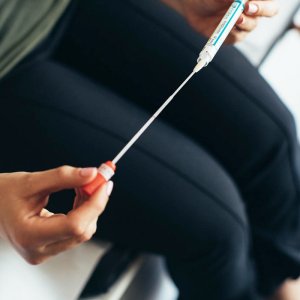'Don’t put it off': Expert encourages Australians to screen for this 'highly preventable' cancer
It’s essential that we try to take the best care of our health possible. Of course, regular exercise and a balanced diet are a must, but it also stands to reason that regular health checks should be part of our routine.
Cervical cancer continues to take lives in Australia each year, but with regular screening, it is highly preventable, according to New South Wales’s Chief Cancer Officer.
NSW Chief Cancer Officer and Cancer Institute NSW Chief Executive Tracey O’Brien urged all eligible Aussies to stay up to date with their cervical screening, as research shows 70 per cent of cervical cancer cases occur in people who missed their recommended screening.
'This is a highly preventable cancer that is still taking lives unnecessarily,' said Ms O’Brien.
'Regular screening is your best chance of detecting this cancer early and getting effective treatment. It’s also a highly treatable cancer if detected early,' she added.
Cervical cancer develops from persistent infections of high-risk human papillomavirus (HPV) that cause cell changes in the cervix. Screening tests check for these HPV infections and precancerous lesions.
Until recently, the invasive Pap test was used—collecting cells from the cervix for examination under a microscope.
However, since 2017, the cervical screening test directly screens for HPV and is more accurate at predicting risk.
The Department of Health and Aged Care’s National Cervical Screening Program encourages people between the ages of 25 and 74 to have their cervix checked every five years through their healthcare provider.
Since July 1, 2022, people can access the program’s self-collection cervical screening tests instead of the procedure performed by a medical practitioner.
In the last 12 months, 13,000 patients have participated in the self-collection cervical screening tests.
Karen Price of ACON, a New South Wales-based HIV and LGBTQ+ health organisation, said self-collection has been 'a game changer' in marginalised communities where screening rates are lower.
'It’s more private and empowering. You’re in control of your own health experience in that clinical setting. It also overcomes some of the potential reasons to not do it,' said Ms Price.
The organisation also partnered with Cancer Institute New South Wales in a campaign to boost the self-collection cervical screening test in younger people.
‘Don’t put it off because we know that early detection means that people’s outcomes are much better,’ Ms Price stated.
In Australia, over 900 women were diagnosed with cervical cancer in 2022, and around 222 succumbed to the disease.
But along with the HPV vaccines, the screening can help the country continue on its track to eliminate cervical cancer by 2035.
The government has pledged $300,000 to train 200 midwives and 50 Aboriginal health workers on cervical testing.
New South Wales Health Minister Ryan Park said: ‘More than 1,000 NSW health professionals have already been trained on self-collection, with the latest round of training helping us move that one step closer to achieving our goal of eliminating cervical cancer by the mid-2030s.’
If you or your loved one is due for a cervical screening, contact your general practitioner (GP) or healthcare provider to book one.
To learn more about the National Cervical Screening Program, visit their website here.
For more details on self-collection cervical screening tests, head to this website.
Here’s what happens on a cervical screening test:

What do you think of this story, members? Have you or anyone you know completed this screening? Let us know in the comments below!
Cervical cancer continues to take lives in Australia each year, but with regular screening, it is highly preventable, according to New South Wales’s Chief Cancer Officer.
NSW Chief Cancer Officer and Cancer Institute NSW Chief Executive Tracey O’Brien urged all eligible Aussies to stay up to date with their cervical screening, as research shows 70 per cent of cervical cancer cases occur in people who missed their recommended screening.
'This is a highly preventable cancer that is still taking lives unnecessarily,' said Ms O’Brien.
'Regular screening is your best chance of detecting this cancer early and getting effective treatment. It’s also a highly treatable cancer if detected early,' she added.
Cervical cancer develops from persistent infections of high-risk human papillomavirus (HPV) that cause cell changes in the cervix. Screening tests check for these HPV infections and precancerous lesions.
Until recently, the invasive Pap test was used—collecting cells from the cervix for examination under a microscope.
However, since 2017, the cervical screening test directly screens for HPV and is more accurate at predicting risk.
The Department of Health and Aged Care’s National Cervical Screening Program encourages people between the ages of 25 and 74 to have their cervix checked every five years through their healthcare provider.
Since July 1, 2022, people can access the program’s self-collection cervical screening tests instead of the procedure performed by a medical practitioner.
In the last 12 months, 13,000 patients have participated in the self-collection cervical screening tests.
Karen Price of ACON, a New South Wales-based HIV and LGBTQ+ health organisation, said self-collection has been 'a game changer' in marginalised communities where screening rates are lower.
'It’s more private and empowering. You’re in control of your own health experience in that clinical setting. It also overcomes some of the potential reasons to not do it,' said Ms Price.
The organisation also partnered with Cancer Institute New South Wales in a campaign to boost the self-collection cervical screening test in younger people.
‘Don’t put it off because we know that early detection means that people’s outcomes are much better,’ Ms Price stated.
In Australia, over 900 women were diagnosed with cervical cancer in 2022, and around 222 succumbed to the disease.
But along with the HPV vaccines, the screening can help the country continue on its track to eliminate cervical cancer by 2035.
The government has pledged $300,000 to train 200 midwives and 50 Aboriginal health workers on cervical testing.
New South Wales Health Minister Ryan Park said: ‘More than 1,000 NSW health professionals have already been trained on self-collection, with the latest round of training helping us move that one step closer to achieving our goal of eliminating cervical cancer by the mid-2030s.’
If you or your loved one is due for a cervical screening, contact your general practitioner (GP) or healthcare provider to book one.
To learn more about the National Cervical Screening Program, visit their website here.
For more details on self-collection cervical screening tests, head to this website.
Here’s what happens on a cervical screening test:
Key Takeaways
- New South Wales Chief Cancer Officer urges eligible individuals to have a self-collection cervical screening test after research showed that 70 per cent of patients diagnosed with cervical cancer were not up to date with screening.
- The self-collection cervical screening test allows patients to collect their own samples and is an effective way to break down barriers to screening in diverse communities.
- Since July 1, 2022, over 13,000 patients have participated in self-collection cervical screening tests.
- The New South Wales government has committed $300,000 to train health professionals in self-collection as part of a goal to eliminate cervical cancer by the mid-2030s.
What do you think of this story, members? Have you or anyone you know completed this screening? Let us know in the comments below!








